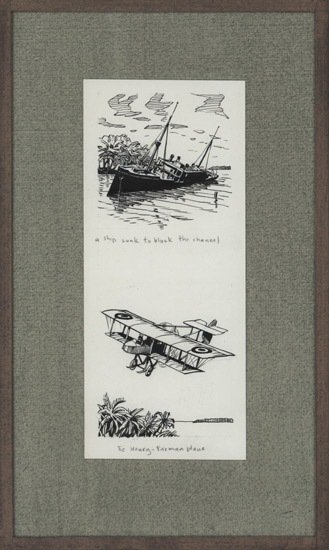
a ship sunk to block the channel and The Henry-Farman plane
Passe-partout (ref: 4872)
Inscribed with title
Pen and ink with highlights in white, 8 x 3 1/2 in. (20 x 8.5 cm.), 11 1/2 x 7 in. (29 x 17.5 cm. framed)

Inscribed with title
Pen and ink with highlights in white, 8 x 3 1/2 in. (20 x 8.5 cm.), 11 1/2 x 7 in. (29 x 17.5 cm. framed)
Between 1934 and 1958 Sheppard illustrated well over 100
books. The majority of these date from the 1950’s when Sheppard
was often illustrating as many as ten a year – a prodigious
rate tragically cut short by his death at the age of 45. Commissions
from over fifteen publishing houses (Hutchinson, Blackie
and Son, Macmillan, Oxford University Press, Faber and Faber)
included illustrations for leading authors of the day such as Enid
Blyton, (two books in 1948 as well contributing to a regular annual
she wrote all the stories for), Jim Corbett (six titles between
1947 and 1955) and, perhaps most notable of all, a commission
in 1952 (shared with Tunnicliffe) to illustrate Ernest Hemingway’s
The Old Man and the Sea.
Equally successful was Sheppard’s career as an illustrator for comics
such as Eagle, Girl, and Swift, and magazines such as Boy’s Own
Paper, Lilliput, Everbody’s, Picture Post, and Reynolds News. Lilliput
was founded in 1937 by Stefan Lorant , (the photo journalist who
later created Picture Post), with a subtitle of “The Pocket Magazine
for Everyone.” Its original size was allegedly such that it could be
slipped into a soldier’s trenchcoat and was no doubt read in many
an air-raid shelter in that handy size. During its 23 year run the
magazine contained the illustrations of Mervyn Peake, Eric Fraser,
Frank Bellamy (of Dan Dare fame) and, perhaps most famously,
Ronald Searle’s cartoon series St. Trinians. The magazine became
known for its photographs too, with work by Brassai, Zoltan
Glass and also Bill Brandt. The magazine subtitle was changed
in September 1954 to “Lilliput is a Man’s Magazine” . From a
starting position of 216,562 in 1938 - double that of Punch at the
time - by May 1959 Lilliput was only selling circa102,000 copies
- number 277, July 1960, was the last issue at which point it was
merged with Men Only.